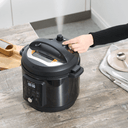Pressure cookers have been a kitchen staple for decades, prized for their ability to cook food quickly and efficiently. Whether you’re a seasoned home cook or a kitchen novice, understanding how a pressure cooker works can help you make the most of this versatile appliance. In this blog post, we’ll delve into the science behind pressure cookers, explore their benefits, and provide tips for using them effectively.
The Science Behind Pressure Cookers
At its core, a pressure cooker is a sealed pot that uses steam pressure to cook food. Here’s a breakdown of how it works:
- Sealed Environment: When you place food and a certain amount of liquid (such as water, broth, or sauce) into the pressure cooker and seal the lid, you create a closed environment.
- Heating the Liquid: As the pressure cooker heats up, the liquid inside begins to boil and produce steam.
- Increased Pressure: The trapped steam increases the pressure inside the cooker. A typical pressure cooker can reach pressures about 12 to 15 psi (pounds per square inch) above normal atmospheric pressure.
- Higher Boiling Point: Under increased pressure, the boiling point of the liquid rises from 100°C (212°F) to around 121°C (250°F). This higher temperature allows the food to cook much faster than it would at a normal boiling point.
- Cooking the Food: The combination of high heat and steam pressure cooks the food quickly and evenly, tenderising tough cuts of meat, breaking down fibres in vegetables, and preserving flavours and nutrients.
- Pressure Release: Once the cooking time is complete, the pressure must be released safely. This can be done quickly using the quick-release method or gradually using the natural release method, depending on the recipe and desired outcome.
Benefits of Using a Pressure Cooker
- Time Efficiency: Pressure cookers can reduce cooking times by up to 70%, making them ideal for busy households and time-sensitive meals.
- Energy Efficiency: Because they cook food faster, pressure cookers use less energy compared to conventional cooking methods.
- Nutrient Preservation: The shorter cooking time and sealed environment help preserve vitamins and minerals that can be lost through prolonged cooking.
- Enhanced Flavour: The high-pressure environment intensifies flavours, making soups, stews, and braised dishes especially rich and tasty.
- Versatility: From soups and stews to rice, beans, and even desserts, pressure cookers can handle a wide variety of recipes, making them a versatile tool in any kitchen.

